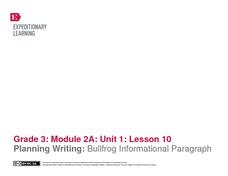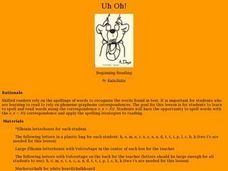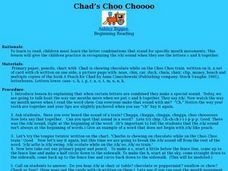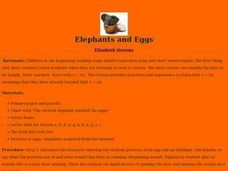Curated OER
Fast Like a Rabbit
First graders identify and interpret what fluency means and relate it to a rabbit hopping along fast without messing up. They close their eyes and picture a book in their minds that they really love to read and locate it on the...
Curated OER
The Perilous Fight: WWII - Up Close and Personal
Students research World War II primary source documents and write first person historical point of view stories.
Curated OER
Visualize and Draw to Increase Comprehension
Improve readers' comprehension with a pair of visualization opportunities. First they listen, eyes closed, as you read a description from Roald Dahl's James and the Giant Peach, and discuss ideas about what they "see." After you read...
Curated OER
Growing in Character
Young scholars explore how to build their character by respecting and appreciating various cultures. In this character education instructional activity, students read the book Seedfolks and answer questions based on the character's...
Curated OER
Read It, See It!
Students review the concept of silent reading and discuss the meaning of visualization. They listen to a poem as it is read and close their eyes to try to make a picture of what is happening and think about the qualities the wind...
Curated OER
Turn Reading into Watching a Movie!
Students practice visualization by imagining what their favorite person looks like, what they are wearing and doing. They share their imaginings with a partner. Next, listen to a poem while visualizing. Finally, they read along as the...
Curated OER
Reading Predictions
Second graders read and predict content and purpose for table of contents, index, headings, captions, illustrations, and major words from their science or social studies textbooks. They use books' elements to summarize what they can find...
Curated OER
Read Us a Story
Students take turns reading a story using a book on tape/cd. Special education students are encouraged to control the story telling by using the buttons on the tape/cd player. The instructor should interject with various questions about...
Curated OER
Beginning Reading
Learners explore the various sounds that make up written words. They investigate the /o/ sound by creating a meaningful representation. Students spell and read words that contain the /o/ sound. They recite tongue twisters.
Curated OER
Multisensory Sight-word Strategies
Students engage in a lesson that uses sight word strategies in order to increase reading comprehension. The skills are applicable to rote skill, math facts, formulas, etc... The lesson includes sample exercises for the teacher to use for...
Curated OER
Can You See It?
Students discuss how to visualize while reading. They read The Thanksgiving Day Parade and Old Yeller. Students relax and picture their favorite place. They share what they saw and discuss the concept of visualization. Students visualize...
Curated OER
Picture This
Students examine how to create mental images to help them comprehend what they read. They discuss what it means to visualize and they draw a mental picture of what they read. Students draw a picture of what they see in their minds while...
EngageNY
Planning Writing: Bullfrog Information Paragraph
Lesson ten in this unit for the book Bullfrogs at Magnolia Circle, prepares third graders to begin writing an informational paragraph about the adaptations of bullfrogs. First, young writers work either independently or in pairs to...
Curated OER
Jackie Steals Home
Students draw on their previous studies of American history and culture as they analyze primary sources from Jackie Robinson and Other Baseball Highlights, 1860s - 1960s in American Memory. A close reading of two documents relating to...
Curated OER
Uh Oh!
Help your elementary learners distinguish between short and long vowel /o/ sounds. They are introduced to the vowel-consonant-e pattern that changes short vowel sounds into long vowel sounds. Then they practice reading and spelling words...
Curated OER
Lesson Plan fo The Magic Eyes of Little Crab
Interested in a "how and why" story to read with young students? In this storytelling lesson, readers will discuss sea creatures, focusing on practicing new terminology through retelling the story. This resource provides a list of...
Curated OER
Why Do Authors Write?
Sixth graders use short reading passages to identify, explain, and discuss the author's purpose for writing. After a lecture/demo, they utilize a graphic organizer embedded in this plan to organize their writing ideas.
Curated OER
Chad's Choo Choooo
Choo, choo! Do your youngsters like trains? After studying the target sound, have your learners read A Peach for Chad. Do a class read and an independent read to increase fluency. At the lesson's close, consider creating a ch train where...
Curated OER
Using a Computer to Write a Letter: Verbs
Review the procedure of using a word processor to write a letter. Writers read 20 sentences that are each missing one action verb. They use the words in the word bank to complete the sentences.
Curated OER
Legend of The Lorax
Young scholars explore ecosystems. They read or listen to Dr. Seuss' The Lorax to draw conclusions and make predictions about the environmental impact and use of resources. They write poems about real forests and the wildlife which...
Curated OER
Elephant Eggs
Study the short and long sounds of the letter e. Learners will practice words and tongue twisters using both the short and long vowel /e/. They use letter boxes and letter tiles to spell words containing the target sound. To close the...
Curated OER
Tyrone, the Horrible
Read a Hans Wilhelm story and complete creative writing activities. Start by reading Tyrone, the Horrible and discuss the behavior in the book. Then split your class into groups to create a "bully" situation and discuss possible...
Curated OER
Story Map for Bud, Not Buddy
Why should your class complete a story map? After reading Bud, Not Buddy, divide your class into pairs or small groups to complete the included worksheet. They list the main characters, the conflict, main plot events, the resolution, and...
Achievement Strategies
CCSS Unit Design Template for Art
Art classes, like any lab class, require extensive preplanning and set-up time. Use this planning template in the quiet before the storm to identify the equipment and materials that will be needed, the procedures and processes...

























